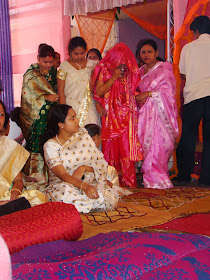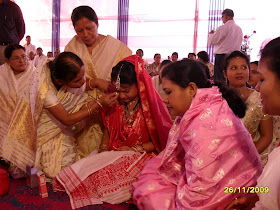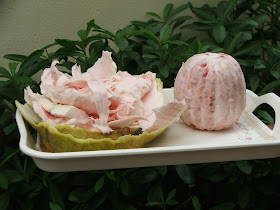 The wedding day started here with the groom's dad performing NAU-PURUSH SHARADHA(a special ceremony in honor of last nine generation ancestors from the groom's father side and the last three generations from the mother's side).It is like presenting the departed souls an invitation to this auspicious ceremony.Here you can see groom's dad performing the ritual according to vedic rules.
The wedding day started here with the groom's dad performing NAU-PURUSH SHARADHA(a special ceremony in honor of last nine generation ancestors from the groom's father side and the last three generations from the mother's side).It is like presenting the departed souls an invitation to this auspicious ceremony.Here you can see groom's dad performing the ritual according to vedic rules. After the Shradha all the family members seek blessings from the priest to start the other rituals.Now you can see the ladies of the family preparing for PANI TULA which means collecting the sacred water for the ceremonial bath of the groom.This ritual is followed by both the sides.The bride wears a mekhela-chadar set presented by the groom's mom specially for this ritual and after the rituals she never wears that set again,it is left back or gifted to someone else.
After the Shradha all the family members seek blessings from the priest to start the other rituals.Now you can see the ladies of the family preparing for PANI TULA which means collecting the sacred water for the ceremonial bath of the groom.This ritual is followed by both the sides.The bride wears a mekhela-chadar set presented by the groom's mom specially for this ritual and after the rituals she never wears that set again,it is left back or gifted to someone else. Groom's mom and the other women mostly relatives and friends go to a river or a pond nearby to collect the water.A DULONI (a brass stand as you can see cousin of the groom holding in the picture above) is prepared which contains a lighted saki (lamp) over a heap of the same rice grain which was brought back from the bride's house during JURAN ceremony,one pair of tamul-pan(betel nut and leaves), a coin and a knife.Five earthen vessels covered with five mango leaves are needed - the main vessel is carried by the groom's mom and the other four by the other relatives.Ladies sing biya naam(wedding songs) and uluni(a special sound made by rolling the tongue inside the mouth).The group the proceeds to the river or the pond.
Groom's mom and the other women mostly relatives and friends go to a river or a pond nearby to collect the water.A DULONI (a brass stand as you can see cousin of the groom holding in the picture above) is prepared which contains a lighted saki (lamp) over a heap of the same rice grain which was brought back from the bride's house during JURAN ceremony,one pair of tamul-pan(betel nut and leaves), a coin and a knife.Five earthen vessels covered with five mango leaves are needed - the main vessel is carried by the groom's mom and the other four by the other relatives.Ladies sing biya naam(wedding songs) and uluni(a special sound made by rolling the tongue inside the mouth).The group the proceeds to the river or the pond. I don't have the picture where they collect water as i stayed back but i can tell you what happens there.On reaching the river/pond groom's mom takes the permission of the river to collect water by bowing .Here as the mother asks for the water another lady acting as the river questions her ..WHY HAVE YOU COME HERE? The mother replies MY SON IS GETTING MARRIED ,NEED WATER FOR HIS BATH FROM YOU.Again the lady questions WHAT YOU SAW ON YOUR WAY ?The mother replies I SAW LORD SHIVA AND GODDESS PARVATI getting married.Now the mother takes the knife in her hands and crosses the water thrice before filling her vessel with the water....all the five vessels are filled at the same time.Once done the group returns without looking back at the river site.
I don't have the picture where they collect water as i stayed back but i can tell you what happens there.On reaching the river/pond groom's mom takes the permission of the river to collect water by bowing .Here as the mother asks for the water another lady acting as the river questions her ..WHY HAVE YOU COME HERE? The mother replies MY SON IS GETTING MARRIED ,NEED WATER FOR HIS BATH FROM YOU.Again the lady questions WHAT YOU SAW ON YOUR WAY ?The mother replies I SAW LORD SHIVA AND GODDESS PARVATI getting married.Now the mother takes the knife in her hands and crosses the water thrice before filling her vessel with the water....all the five vessels are filled at the same time.Once done the group returns without looking back at the river site. You can the see the group returning back to the house.The groom's mom sprinkles little water from the vessel at her house .Now they all go to the place where NUANI(ceremonial bath) takes place.
You can the see the group returning back to the house.The groom's mom sprinkles little water from the vessel at her house .Now they all go to the place where NUANI(ceremonial bath) takes place. The groom follows his mom by holding an end of a GAMOSA(a traditional cotton cloth) while his mom holds another end.The group takes few rounds around the KOL-PULLI(a freshly planted banana tree),now the ladies keep the vessels on the ground and the groom sits on a special asana(seat).
The groom follows his mom by holding an end of a GAMOSA(a traditional cotton cloth) while his mom holds another end.The group takes few rounds around the KOL-PULLI(a freshly planted banana tree),now the ladies keep the vessels on the ground and the groom sits on a special asana(seat). The ceremony starts with the mother applying oil ,curd and a paste of haldi-mah(turmeric and urad lentils) the same process is followed by all the ladies present .Once this round is completed the groom's mom pours the sacred water from the vessel over the groom's head and again this process is followed by all the ladies present.WE smear the curd and the paste on each others face too.
The ceremony starts with the mother applying oil ,curd and a paste of haldi-mah(turmeric and urad lentils) the same process is followed by all the ladies present .Once this round is completed the groom's mom pours the sacred water from the vessel over the groom's head and again this process is followed by all the ladies present.WE smear the curd and the paste on each others face too. After the bath groom wears a fresh set of cloth and seeks blessing of his mom and all the other ladies present.Within few hrs. the groom proceeds towards the bride's home for the main wedding ceremony.
After the bath groom wears a fresh set of cloth and seeks blessing of his mom and all the other ladies present.Within few hrs. the groom proceeds towards the bride's home for the main wedding ceremony.
v























 There are also several references to the fact that in Southern part of India the sari had been for a long time one piece of material that served as both skirt and veil, leaving the bosom bare.
There are also several references to the fact that in Southern part of India the sari had been for a long time one piece of material that served as both skirt and veil, leaving the bosom bare. In North Indian miniature paintings, (particularly Jain, Rajasthani and Pahari schools from the 13th to the 19th centuries) the sari consisted of the diaphanous skirt and an equally diaphanous veil draped over a tiny bodice.
In North Indian miniature paintings, (particularly Jain, Rajasthani and Pahari schools from the 13th to the 19th centuries) the sari consisted of the diaphanous skirt and an equally diaphanous veil draped over a tiny bodice.

 In the following posts on this page we shall continue to bring forth the various weaves, textiles and drape forms of the saree as is worn in the different parts of our country.
In the following posts on this page we shall continue to bring forth the various weaves, textiles and drape forms of the saree as is worn in the different parts of our country.





